Question 1.
What is Unit?
Answer:
A unit is a standard measure used for comparing measurements.
Question 2.
Why do we use different units for different items?
Answer:
Depending on the quantities of material the units may be expressed.
Question 3.
Write fundamental quantities in MKS system.
Answer:
Mass (m), Length (l) and Time (t).
Question 4.
What are fundamental quantities?
Answer:
Fundamental quantities are those physical quantities that cannot be expressed in terms of other quantities.
Question 5.
What is fundamental unit?
Answer:
Units used to express fundamental quantities are called fundamental units.
Question 6.
Write fundamental units in MKS system.
Answer:
Meter, Kilogram and Second.
Question 7.
What is CGS system?
Answer:
Centimeter, Grams and Seconds.
Question 8.
What is SI system? When was it introduced?
Answer:
SI system means International System of units. It was introduced in 1971.
Question 9.
List the fundamental quantities that are added to SI system.
Answer:
Electricity, light intensity, quantity of substance, temperature and plane angle.
Question 10.
What is difference between MKS and SI systems?
Answer:
- MKS system has only three fundamental quantities. Those are length, mass and time.
- SI system has eight fundamental quantities. Those are length, mass, time, electricity, light intensity, quantity of substance, temperature, plane angle.
Question 11.
What is derived quantity?
Answer:
The quantities that are obtained by combining fundamental quantities either by multiplication or division or both operations are called derived quantities.
Question 12.
What are derived units?
Answer:
The derived units of measurement derived from the fundamental units.
Question 13.
Write derived units of area and volume.
Derived units of area = m2
Derived units of volume = msup3
Question 14.
What are the fundamental units are used to express the units of Force?
Answer:
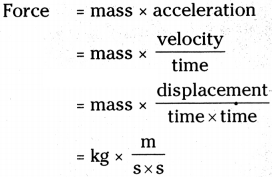
Hence fundamental units used to express force are kg, m, s.
Question 15.
Which conversion factor is used to convert kilometers into meter?
Answer:
1000.
Question 16.
Which conversion factor is used to convert meters into kilometers?
Answer:
10-3.
Question 17.
Write conversion factor to convert km/hr into m/s.
Answer:
518
Question 18.
Write some units of measurements expressed in the name of scientists.
Answer:
Newton (N), Pascal (Pa), Joule (J), Watt (W), etc.
Question 19.
What is graph?
Answer:
A pictorial form of representation that shows the relation between two quantities can be called a graph.
Question 20.
What are independent and dependent variables?
Answer:
Independent variables are controlled by us. Whereas dependent variables are changed due to the change in dependent variable.
Question 21.
Which variable is taken on x - axis?
Answer:
Independent variable.
Question 22.
What are grids on graph paper?
Answer:
On a graph paper, there are thick as well as fine vertical and horizontal lines. These intersecting lines form squares or grids.
Question 23.
What is Range?
Answer:
Range = highest value - lowest value.
Question 24.
What is scaling?
Answer:
Pointing of the values in the table on x - axis and y - axis is called scaling.
Question 25.
What is scale?
Answer:
The interval taken pointing values on axis is called scale.
Question 26.
How do you find x - axis scale?
Answer:

Question 27.
What is curved line graph?
Answer:
If a graph is in curved shape, then it is curved line graph.
Question 28.
What is Hooke’s law?
Answer:
The elongation of the spring is proportional to the applied mass within the elastic limit of the spring.
Question 29.
What is slope of the straight line graph?
Answer:

Question 30.
What is slope of a graph?
Answer:
The tan value of the angle at x - axis is the slope of a graph.
tan θ = Δy/Δx
Question 31.
What is area of a graph?
Answer:
The product of the physical quantity of y - axis and x - axis may explain another physical quantity. Hence, it is said to be area of the graph.
Question 32.
What does slope indicate to the graph of displacement and time?
Answer:
Velocity.
Question 33.
What does area of the graph of acceleration Vs time indicate?
Answer:

Question 34.
Predict shape of the graph if you plot a graph by taking time on x - axis and velocity of a free fall body on y - axis.
Answer:
Straight line.
Question 35.
Guess the shape of the graph if you plot a graph of time and distance covered by a bus.
Answer:
Curved graph.
Question 36.
Rithvik wrote ‘3 kgs of sugar’ on the black board. Correct him by asking a question.
Answer:
Is it correct to mention kg in plural form while writing units?
Question 37.
Karthik got a doubt by seeing ‘3 newtons’ on the black board. What would be it?
Answer:
Which quantity is measured in newtons ?
Question 38.
What are the materials / apparatus required to prove Hooke’s law?
Answer:
- Spring,
- Weights,
- Scale,
- Stand.
Question 39.
Area, volume, density, mass
a) Write any one fundamental quantity from the above data.
b) Write any one derived quantity from the above data.
Answer:
a) mass.
b) volume.
Question 40.
‘Dheeraj counted distance travelled by him for every 10 min.’
From the above data write independent and dependent variables.
Answer:
Time (min) is independent variable distance is dependent variable.
Question 41.
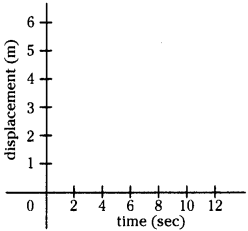
Plot the data points (6, 4) and (0, 0) in the above graph.
Answer:
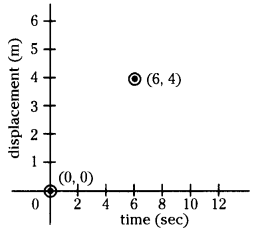
Question 42.
How do you remember scientists through units of measurements?
Answer:
Some units are expressed in the names of the scientists like newton, joule, etc. When we use these units, scientists are remember once again.
Question 43.
What is the use of graph?
Answer:
- We can solve so many problems by using graphs.
- We can know the relation between two physical quantities through graphs.
Question 44.
Calculate the Range of 5, 7, 3, 8, 18, 4, 2, 6.
Answer:
Range = highest value – lowest value
= 18-2 = 16.
Question 45.
If the range is 10 and no. of grids horizontally is 20. How can you take scale X-axis?
Answer:

2) I will take 0.5,1,1.5, 2, 2.5,3,3.5, 4, 4.5, 10 on the X-axis. As a scale on x-axis.
Question 46.
How slope of displacement Vs time graph is useful?
Answer:
We can calculate velocity by calculating slope of line in displacement Vs time graph.
Question 47.
How area of velocity Vs time graph is useful?
Answer:
Area of velocity Vs time graph is useful to find the position of the object.
Question 48.
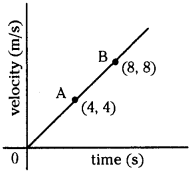
What is the acceleration at ‘B’?
Answer:

Acceleration is 1 m/s2.
Question 49.
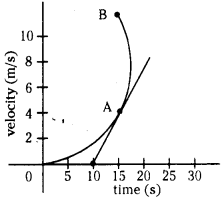
Find the acceleration at ‘A’.
Answer:

Question 50.
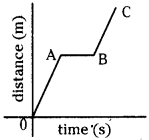
How much distance is travelled by the object from A to B in the graph?
Answer:
Zero.
Question 1.
What is a unit? Where it be placed?
Answer:
- A unit is a standard measure used for comparing measurements.
- Unit should be placed right side of the magnitude of every physical quantity. For eg : 2 kg, 7 m.
Question 2.
Differentiate fundamental quantities and derived quantities.
Answer:
| Fundamental quantity |
Derived quantity |
| 1) Fundamental quantities are those physical quantities that cannot be expressed in terms of other quantities. |
1) The quantities that are obtained by combining fundamental quantities either by multiplication or division or both are called derived quantities. |
| 2) These are independent. |
2) These are dependent. |
| 3) Eg : Mass, length, time. |
3) Eg : Area, density, force. |
Question 3.
Derive units of density.
Answer:

Question 4.
Write different system of measurements.
Answer:
- FPS : Foot, Pound, Second.
- CGS : Centimeter, Gram, Second.
- MKS : Meter, Kilogram, Second.
- SI : Meter, Kilogram, Second, Ampere, Candela, Mole, Kelvin, Radian.
Question 5.
Derive units to the given physical quantities.
Answer:

Question 6.
Which of the following are correct? Why?
Answer:
A) m/s
B) m/s/s
C) m-s2
D) 10.kgs
E) Pascal
F) joule
Answer:
A) and F) only are correct
B) two solidus are used - wrong.
C) line break is used - wrong.
D) ‘•’ and plural of kg are used - wrong.
E) capital letter used (P) - wrong.
Question 7.
Write correct form of units in the following.
(j) DB
(ii) mhz
(iii) 20 - m
(iv) kg.m-s-2
Answer:
(i) dB
(ii) MHz
(iii) 20 m
(iv) Kg.m.s-2
Question 8.
How do you expect the shape of the given graphs?
(a) a ∝ b
(b) a ∝ 1/b
Answer:
a) It may be straight line graph.
b) It may be curved line graph.
Question 9.
From the graph,
a) What is indicated by slopes of the lines OA, OB, OC?
b) Which line shows high speed than other lines? Why?
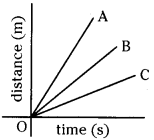
Answer:
a) Slopes of the lines indicate speeds of the objects.
b) OA shows high speed than other lines.
Because it has high slope than others.
Question 10.

a) Which is independent variable?
b) Which is dependent variable?
c) Predict how the graph is.
d) Find the range on Y - axis.
Answer:
a) Mass
b) Weight
c) It may be in straight line.
d) On Y - axis, values are 98, 196, 294, 392, 490.
Range = 490 - 98 = 392
Question 11.
Plot the given data points on the given graph paper and join the dots.
Data points : (8, 10) (20, 15) (40, 22.5) (48, 0)
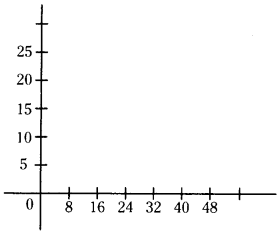
Answer:
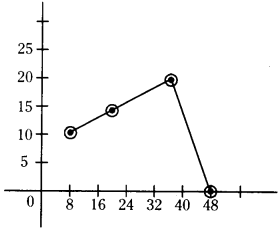
Question 12.
Draw a graph roughly to show uniform velocity of a body.
Answer:
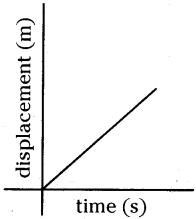
Question 13.
Draw a graph that shows a body without movement after travelling sometime.
Answer:
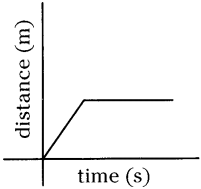
Question 14.
How do you appreciate the role of graphs in solving problems?
Answer:
- Graphs can be used to compare different physical quantities like time- displacement, time-velocity, pressure-volume, etc. and helps in solve the problems.
- Graphs are very useful to find the path of an object which is in motion and it is easy to calculate velocity, acceleration, position, etc. at particular time and particular point of the object.
- Graphs are very useful minimum, maximum values of some physical quantities. For example to find minimum deviation of a prism graphs are very useful.
- In this way graphs are appreciable for their role in solving problems.
Question 15.
From the given graph find the slope and area at point B.
Answer:

Question 16.
Convert 3 m/s into km/hr.
Answer:
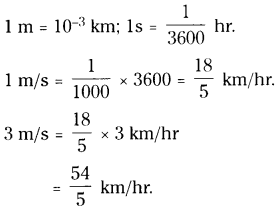
Question 17.
A ball of 100 g mass is thrown with initial velocity of 0.01 km/s. What is its momentum at that time?
Answer:
Momentum = mass × velocity
Here, mass of the ball = 100 gr = 100 × 1/100 kg ⇒ m = 0.1 kg
Velocity of the ball = 0.01 km/s = 0.01 × 1000 m/s ⇒ v = 10 m/s
Momentum of the ball = mxv = 0.1 × 10 kg.m/s = 1 kg.m/s
Question 18.

Find the temperature on Day - 4 by using graph.
Answer:
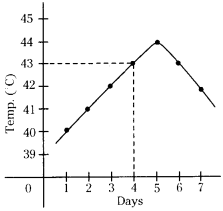
From the graph the temperature on day - 4 is 43°C.
Question 19.
Observe table and answer the following.
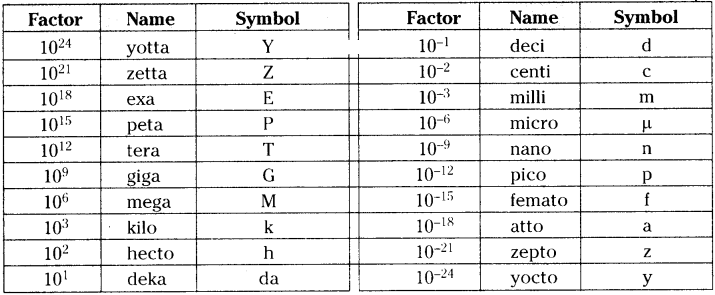
i) 12 cm = …………. m
ii) 2 nm = …………. cm
Answer:
i) 12 cm = 12 × 10-2m
ii) 2 nm = 2 × 10-7cm
[From the table 1 nanometer = 10-9m; 1 centimeter = 10-2m.
1 nanometer to centimeter conversion factor = 10-9-(-2)= 10-7.]